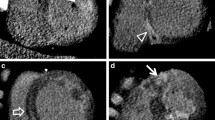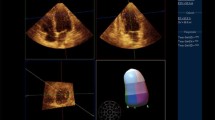Abstract
Objectives
Late enhancement (LE) multi-slice computed tomography (leMDCT) was introduced for the visualization of (intra-) myocardial fibrosis in Hypertrophic Cardiomyopathy (HCM). LE is associated with adverse cardiac events. This analysis focuses on leMDCT derived LV muscle mass (LV-MM) which may be related to LE resulting in LE proportion for potential risk stratification in HCM.
Methods
N=26 HCM-patients underwent leMDCT (64-slice-CT) and cardiovascular magnetic resonance (CMR). In leMDCT iodine contrast (Iopromid, 350 mg/mL; 150mL) was injected 7 minutes before imaging. Reconstructed short cardiac axis views served for planimetry. The study group was divided into three groups of varying LV-contrast. LeMDCT was correlated with CMR.
Results
The mean age was 64.2 ± 14 years. The groups of varying contrast differed in weight and body mass index (p < 0.05). In the group with good LV-contrast assessment of LV-MM resulted in 147.4 ± 64.8 g in leMDCT vs. 147.1 ± 65.9 in CMR (p > 0.05). In the group with sufficient contrast LV-MM appeared with 172 ± 30.8 g in leMDCT vs. 165.9 ± 37.8 in CMR (p > 0.05). Overall intra-/inter-observer variability of semiautomatic assessment of LV-MM showed an accuracy of 0.9 ± 8.6 g and 0.8 ± 9.2 g in leMDCT. All leMDCT-measures correlated well with CMR (r > 0.9).
Conclusions
LeMDCT primarily performed for LE-visualization in HCM allows for accurate LV-volumetry including LV-MM in > 90 % of the cases.
Key Points
• LeMDCT of relatively low contrast allows for LV planimetry in HCM.
• The correlation of leMDCT-based LV volumetry with gold-standard CMR was excellent (r > 0.9).
• LeMDCT requires approximately 2.0mL/kgBW of dye to achieve acceptable contrast.




Similar content being viewed by others
Abbreviations
- BMI:
-
Body mass index
- BW:
-
Body weight
- CAD:
-
Coronary artery disease
- CMR:
-
Cardiovascular magnetic resonance
- CNR:
-
Contrast-to-noise ratio
- DLP:
-
Dose-length product
- ED:
-
Effective dose
- HCM:
-
Hypertrophic cardiomyopathy
- HU:
-
Hounsfield units
- LeMDCT:
-
Late enhanced multi-slice computed tomography
- LE:
-
Late enhancement
- gLE:
-
LE mass
- %LE:
-
LE proportion
- LGE:
-
Late gadolinium enhancement
- LV:
-
Left ventricle
- LV-EDV:
-
Left ventricular end-diastolic volume
- LV-EF:
-
Left ventricular ejection fraction
- LV-ESV:
-
Left ventricular end-systolic volume
- LV-MM:
-
Left ventricular muscle mass
- LV-SV:
-
Left ventricular stroke volume
- MPR:
-
Multi-planar reformation
- SNR:
-
Signal-to-noise ratio
References
Frey N, Luedde M, Katus HA (2012) Mechanisms of disease: hypertrophic cardiomyopathy. Nat Rev Cardiol 9:91–100
Maron BJ, Maron MS (2013) Hypertrophic cardiomyopathy. Lancet 381:242–255
Kwon DH, Smedira NG, Rodriguez ER et al (2009) Cardiac magnetic resonance detection of myocardial scarring in hypertrophic cardiomyopathy: correlation with histopathology and prevalence of ventricular tachycardia. J Am Coll Cardiol 54:242–249
Schulz-Menger J, Bluemke DA, Bremerich J et al (2013) Standardized image interpretation and post processing in cardiovascular magnetic resonance: Society for Cardiovascular Magnetic Resonance (SCMR) board of trustees task force on standardized post processing. J Cardiovasc Magn Reson 15:35
Green JJ, Berger JS, Kramer CM, Salerno M (2012) Prognostic value of late gadolinium enhancement in clinical outcomes for hypertrophic cardiomyopathy. JACC Cardiovasc Imaging 5:370–377
Lorell BH, Carabello BA (2000) Left ventricular hypertrophy: pathogenesis, detection, and prognosis. Circulation 102:470–479
Mahnken AH, Koos R, Katoh M et al (2005) Assessment of myocardial viability in reperfused acute myocardial infarction using 16-slice computed tomography in comparison to magnetic resonance imaging. J Am Coll Cardiol 45:2042–2047
Lardo AC, Cordeiro MA, Silva C et al (2006) Contrast-enhanced multidetector computed tomography viability imaging after myocardial infarction: characterization of myocyte death, microvascular obstruction, and chronic scar. Circulation 113:394–404
Furtado AD, Carlsson M, Wintermark M, Ordovas K, Saeed M (2008) Identification of residual ischemia, infarction, and microvascular impairment in revascularized myocardial infarction using 64-slice MDCT. Contrast Media Mol Imaging 3:198–206
Wang R, Zhang Z, Xu L et al (2011) Low dose prospective ECG-gated delayed enhanced dual-source computed tomography in reperfused acute myocardial infarction comparison with cardiac magnetic resonance. Eur J Radiol 80:326–330
Gerber BL, Belge B, Legros GJ et al (2006) Characterization of acute and chronic myocardial infarcts by multidetector computed tomography: comparison with contrast-enhanced magnetic resonance. Circulation 113:823–833
Berliner JI, Kino A, Carr JC, Bonow RO, Choudhury L (2013) Cardiac computed tomographic imaging to evaluate myocardial scarring/fibrosis in patients with hypertrophic cardiomyopathy: a comparison with cardiac magnetic resonance imaging. Int J Cardiovasc Imaging 29:191–197
Zhao L, Ma X, Delano MC et al (2013) Assessment of myocardial fibrosis and coronary arteries in hypertrophic cardiomyopathy using combined arterial and delayed enhanced CT: comparison with MR and coronary angiography. Eur Radiol 23:1034–1043
Funabashi N, Kataoka A, Horie S et al (2013) Distinguishing 320 slice CT-detected focal fibrotic lesions and non-fibrotic lesions in hypertrophic cardiomyopathy by assessment of regional myocardial strain using two dimensional speckle tracking echocardiography. Int J Cardiol 169:e109–e113
Yajima R, Kataoka A, Takahashi A et al (2012) Distinguishing focal fibrotic lesions and non-fibrotic lesions in hypertrophic cardiomyopathy by assessment of regional myocardial strain using two-dimensional speckle tracking echocardiography: comparison with multislice CT. Int J Cardiol 158:423–432
Deux JF, Potet J, Lim P et al (2013) Is multidetector computed tomography a suitable alternative to MR imaging for the assessment of myocardial necrosis after alcohol septal ablation? Int J Cardiol 164:306–311
Langer C, Lutz M, Eden M et al. (2014) Hypertrophic cardiomyopathy in cardiac CT: a validation study on the detection of intramyocardial fibrosis in consecutive patients. Int J Cardiovasc Imaging 30:659–667
Shiozaki AA, Senra T, Arteaga E et al (2013) Myocardial fibrosis detected by cardiac CT predicts ventricular fibrillation/ventricular tachycardia events in patients with hypertrophic cardiomyopathy. J Cardiovasc Comput Tomogr 7:173–181
Gersh BJ, Maron BJ, Bonow RO et al (2011) 2011 ACCF/AHA guideline for the diagnosis and treatment of hypertrophic cardiomyopathy: executive summary: a report of the American College of Cardiology Foundation/American Heart Association Task Force on Practice Guidelines. Circulation 124:2761–2796
Abbara S, Arbab-Zadeh A, Callister TQ et al (2009) SCCT guidelines for performance of coronary computed tomographic angiography: a report of the Society of Cardiovascular Computed Tomography Guidelines Committee. J Cardiovasc Comput Tomogr 3:190–204
Halliburton SS, Abbara S, Chen MY et al (2011) SCCT guidelines on radiation dose and dose-optimization strategies in cardiovascular CT. J Cardiovasc Comput Tomogr 5:198–224
Schuleri KH, Centola M, George RT et al (2009) Characterization of peri-infarct zone heterogeneity by contrast-enhanced multidetector computed tomography: a comparison with magnetic resonance imaging. J Am Coll Cardiol 53:1699–1707
Schroeder J, Peterschroeder A, Vaske B et al (2009) Cardiac volumetry in patients with heart failure and reduced ejection fraction: a comparative study correlating multi-slice computed tomography and magnetic resonance tomography. Reasons for intermodal disagreement. Clin Res Cardiol 98:739–747
McMurray JJ, Adamopoulos S, Anker SD et al (2012) ESC guidelines for the diagnosis and treatment of acute and chronic heart failure 2012: The Task Force for the Diagnosis and Treatment of Acute and Chronic Heart Failure 2012 of the European Society of Cardiology. Developed in collaboration with the Heart Failure Association (HFA) of the ESC. Eur J Heart Fail 14:803–869
Plumhans C, Keil S, Ocklenburg C et al (2009) Comparison of manual, semi- and fully automated heart segmentation for assessing global left ventricular function in multidetector computed tomography. Investig Radiol 44:476–482
Brouwer WP, Germans T, Head MC et al (2012) Multiple myocardial crypts on modified long-axis view are a specific finding in pre-hypertrophic HCM mutation carriers. Eur Heart J Cardiovasc Imaging 13:292–297
Maron MS, Rowin EJ, Lin D et al (2012) Prevalence and clinical profile of myocardial crypts in hypertrophic cardiomyopathy. Circ Cardiovasc Imaging 5:441–447
Lessick J, Abadi S, Agmon Y et al (2012) Multidetector computed tomography predictors of late ventricular remodeling and function after acute myocardial infarction. Eur J Radiol 81:2648–2657
Bettencourt N, Ferreira ND, Leite D et al (2013) CAD detection in patients with intermediate-high pre-test probability: low-dose CT delayed enhancement detects ischemic myocardial scar with moderate accuracy but does not improve performance of a stress-rest CT perfusion protocol. JACC Cardiovasc Imaging 6:1062–1071
Cerqueira MD, Weissman NJ, Dilsizian V et al (2002) Standardized myocardial segmentation and nomenclature for tomographic imaging of the heart. A statement for healthcare professionals from the Cardiac Imaging Committee of the Council on Clinical Cardiology of the American Heart Association. Int J Cardiovasc Imaging 18:539–542
Acknowledgments
We wish to extend our sincere thanks to Mr. Arne Jochens for supervising our biometric analysis, to Ms. Nadin Eichhorn, SIEMENS, for "running the system" and to Ms. Kristi Hillenkamp for proofreading. The scientific guarantor of this publication is Prof. Norbert Frey. The authors of this manuscript declare no relationships with any companies whose products or services may be related to the subject matter of the article. The authors state that this work has not received any funding. No complex statistical methods were necessary for this paper. Institutional Review Board approval was obtained. Written informed consent was obtained from all subjects (patients) in this study. Some study subjects or cohorts have been previously reported (Langer C, Lutz M, Eden M, et al. Hypertrophic cardiomyopathy in cardiac CT: a validation study on the detection of intramyocardial fibrosis in consecutive patients. Int J Cardiovasc Imaging 2014 Mar;30(3):659-67). Methodology: prospective, diagnostic study, multicenter study. Presentations
• American College of Cardiology Foundation Annual Meeting 2013
• European Society of Cardiology Congress 2013
• German Cardiac Society Annual Congress 2013, Fall Meeting 2013.
Author information
Authors and Affiliations
Corresponding author
Additional information
C. Langer and M. Both contributed equally
Rights and permissions
About this article
Cite this article
Langer, C., Both, M., Harders, H. et al. Late enhanced computed tomography in Hypertrophic Cardiomyopathy enables accurate left-ventricular volumetry. Eur Radiol 25, 575–584 (2015). https://doi.org/10.1007/s00330-014-3434-0
Received:
Revised:
Accepted:
Published:
Issue Date:
DOI: https://doi.org/10.1007/s00330-014-3434-0




